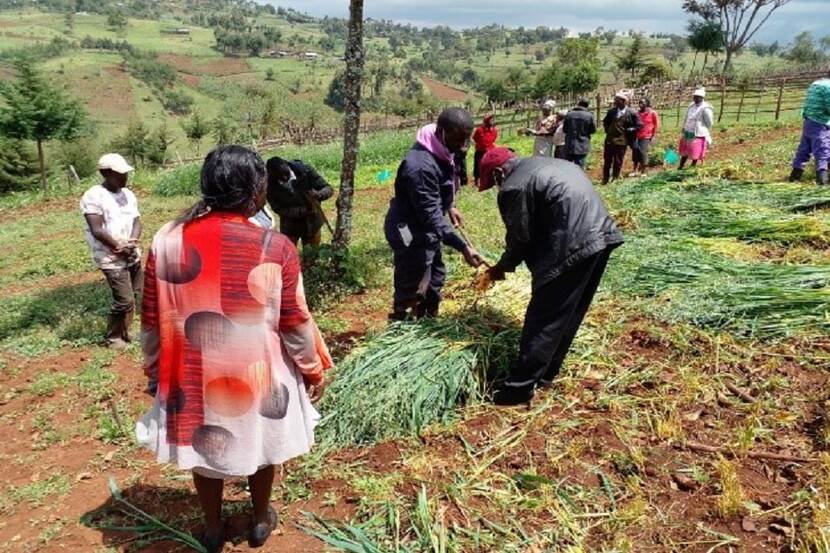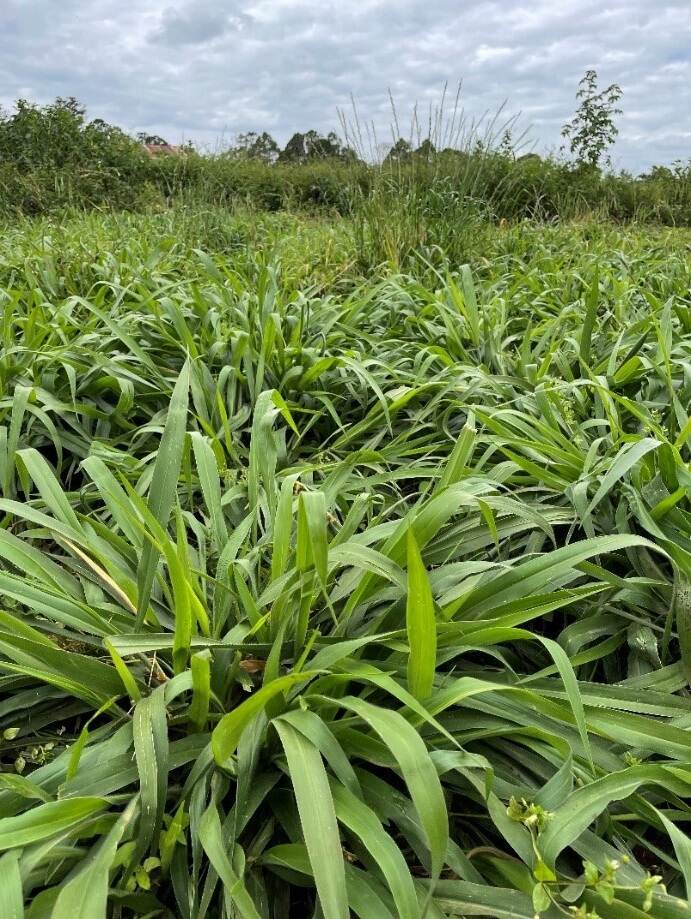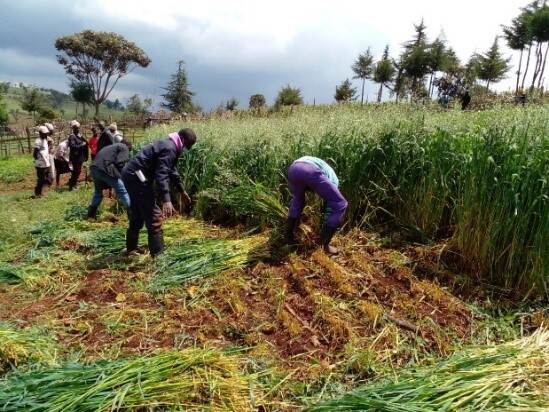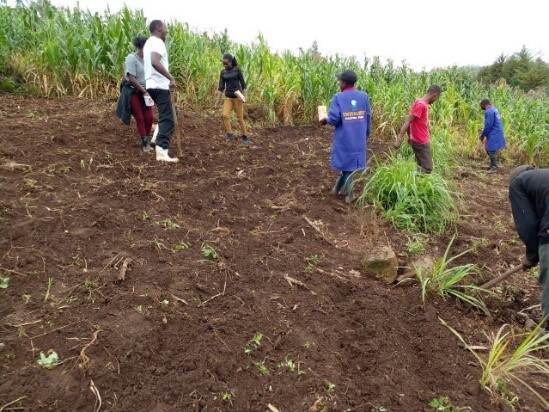Improved forage could boost milk yields in Kenya
The year-round availability of high quality forage is key for a productive dairy system. With ample good quality fodder, production of up to 10 litres per day from forage alone is possible. To reach this level of production it is of prime importance to have superior forage varieties that are suited for the local conditions. For this reason the consortium consisting of WUR, Agriterra, ProDairy, Barenbrug and field partners are working together to establish three trial plots in two cooperatives in Eldoret and Baringo. Various forage seeds are currently trialled to popularize the assorted forage crops and to gain knowledge on the performance of the different forage crops under the specific conditions of the chosen locations.

The importance of the dairy sector in Kenya
Kenya’s dairy sector is the largest in Sub Sahara Africa and within Kenya the largest agricultural sub sector. The dairy sector contributes 14% of Kenya’s agricultural GDP, and Kenya boasts the highest per capita milk consumption in Sub-Saharan Africa, with demand projected to rise.
Currently 80% of the milk is produced by smallholder farmers. Many of these dairy producers have limited knowledge of best practices in animal husbandry and limited access to inputs and markets. Poor rural infrastructure limits access to inputs, increases the costs for milk collection and results in high rates of post-harvest milk loss. Implementation of a coherent national dairy strategy is made difficult by the fragmented, largely informal market.
The above shows that the dairy sector is of considerable importance to Kenya. The fast-growing demand for dairy products can however not be met by the present farming practices and systems. The first and foremost key factor for increasing milk production and reducing the cost price is the feeding of more and better forages (more milk from forages including grasses and legumes).
'Once fed, dairy animals use nutrients from feed to meet their needs to maintain functions first and the rest of the nutrients will be used for growth, production and reproduction', explains Asaah Ndambi from Wageningen University & Research.

Also, good quality forages in combination with balanced rations have a positive impact on reducing methane intensity by dairy cows. At present, the amount and quality of forage fed to dairy cows is at most just enough to meet the need for maintaining body functions of dairy cows. Milk is therefore often produced by feeding expensive concentrates in addition to forages of low quality. Previous studies revealed that the Kenyan forage sector is hindered by several factors such as: limited awareness, access and availability of affordable improved forage seed/plant material, seasonality of forage production due to dependence on rain and insufficient supply and inclusion of quality of forages (including grasses and legumes) in rations of dairy cows. Recommendations of these studies for the forage sector included: Fast tracking access to new (improved) certified forage species/varieties through facilitating and stimulating private seed companies to commercialize local and/or import and register suitable seeds of forages, hand in hand with local and international research institutions. This led to the development and execution of the current “improved forage” project.
The improved forage project
Various suppliers of forage crop seeds and vegetative material in Kenya were identified in previous studies. One of the key companies – Simlaw seeds in partnership with Barenbrug (South Africa) is responsible for the supply of the forage seeds . Based on trials and farmer experiences in other African countries, 9 forage varieties (see picture below) were pre-selected as possible high potential varieties under Kenyan agro-climatic conditions. In its initial phase, this project will set up trails to confirm the performance of these varieties under Kenyan conditions before recommending them further for registration and distribution. The preferred varieties will then be subjected to the National Performance Trials (NPT) performed by Kenya Plant Health Inspectorate Services (KEPHIS) on new crop varieties before their approval for commercialization within Kenya. To reduce the time involved in the registration process It is suggested that the Distinctiveness, Uniformity and Stability (DUS) tests are used from a reputed institute in the country of origin.

In the process it is important to create awareness and train farmers on climate smart agronomic and feeding practices to get the most benefit from the newly introduced superior forage varieties. Wageningen University & Research, Agriterra, ProDairy EA Ltd and field partners will work together to establish trial plots, using the improved forages. This project will support stakeholders in considering the value of improved forage crops for its users (farmers indirectly and cows directly) to maximize the cow’s health and optimize milk production in a more holistic approach. Therefore, farmers should have the possibility of choosing a forage crop which is suitable for their location and farming system, which strikes a balance between yield and quality. Therefore, we intend to suggest an approach for judging the quality of forages based on their ability to meet the feeding needs of dairy cows, not only based on the biomass yield.
Harvesting Oats (measuring the yield biomass)



The Netherlands supports dairy
The Netherlands has in the past and still supports the dairy sector in Kenya. One of the programs supported in the past is the Kenya market-led Dairy Program (KMDP). This is one of the studies which indicated better forage varieties would support the dairy sector in Kenya. As a contribution to the efficiency of the forage crop varieties (incl. grasses and legumes) in Kenya, the Netherlands Enterprise agency together with the Embassy of the Kingdom of Netherlands in Nairobi is supporting this project to test and recommend new and promising forage varieties that might enter the Kenyan market, accompanied by training in Good Agricultural Practices and alignment of the public institutes.
For more information on this project please contact Asaah Ndambi (asaah.ndambi@wur.nl) or Jos Creemers (jos@prodairy.co.ke). In case of other questions for the Agricultural Counsellor feel free to contact us via nai-lnv@minbuza.nl. For the latest updates follow us on twitter @NLAgriKenya or register for our newsletter by sending an email.
Other studies referred to in this article
- Creemers J and A. Alvarez Aranguiz. 2019. Quick Scan of Kenya’s Forage Sub-Sector. Working Paper
Netherlands East African Dairy Partnership (NEADAP)
- Forage Value Chain Analysis For The Counties Of Taita Taveta, Kajiado And Narok (ICSIAPL) Sub report: Scan of forage seed suppliers in Kenya (private companies and research institutions)